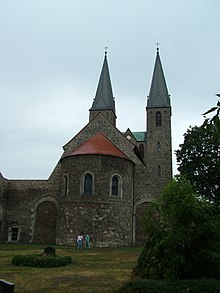Hillersleben
|
Hillersleben
Community Westheide
|
|
|---|---|
| Coordinates: 52 ° 16 ′ 25 ″ N , 11 ° 29 ′ 32 ″ E | |
| Height : | 48 m above sea level NHN |
| Area : | 15.25 km² |
| Residents : | 719 (December 31, 2017) |
| Population density : | 47 inhabitants / km² |
| Incorporation : | January 1, 2010 |
| Postal code : | 39343 |
| Primaries : | 039202, 03904 |
Hillersleben is part of the Westheide community in the Börde district in Saxony-Anhalt .
geography
Hillersleben is about five kilometers east of Haldensleben an der Ohre and about 20 kilometers northwest of Magdeburg .
history
Hillersleben Abbey was founded in the 10th century . The name Hildesleve for the place is first mentioned at the beginning of the 11th century with reference to the monastery. Otto, son of Ludburg and Count Milo von Grieben und Ammensleben, called himself comes de Hildelive (Hildesleve) in the 12th century . In the 12th century a castle in Hillersleben is mentioned, which is said to have stood on the site of the monastery. With Otto von Hillersleben, the Counts of Hillersleben also died out. Presumably the possessions of the counts passed to the margraves of Brandenburg. The monastery gradually took over the property in the village itself. 1376 it received from Archbishop Peter von Magdeburg the whole place in a donation left.
As part of the Schmalkaldic War , a battle between Duke Georg von Mecklenburg and the citizens of Magdeburg near Hillersleben took place on September 22, 1550 . The Magdeburg family lost.
In 1564 there were 26 landlords in the village. 1577 Hillersleben is described in documents as completely Protestant. However, the church had no properties of its own, but was administered by the monastery, which had the right of patronage.
During the Kingdom of Westphalia Hillersleben belonged to the canton of Neuhaldensleben , district of Neuhaldensleben in the Elbe department. The village of Paxförde also belonged to Hillersleben .
On September 30, 1928, the Hillersleben manor district was merged with the Hillersleben rural community.
In connection with the adjacent Altmark military training area in the Colbitz-Letzlinger Heide , the Hillersleben Army Research Institute existed in Hillersleben before and during the Second World War . a. was used to test artillery weapons and the Dora gun . In April 1945 an evacuation transport from the Bergen-Belsen concentration camp reached a forest near Hillersleben, where the guards fled it. In the weeks that followed, women and Red Cross helpers looked after the survivors, while the deceased and those who continued to die every day were buried on the firing range in a specially laid out Jewish cemetery.
After the war, the facilities continued to be used by the Soviet Army until 1994 . T. destroyed. In addition, Hillersleben was the location of the 47th Panzer Division of the Soviet Army Group in Germany . Today the area is used by the Bundeswehr for military exercises.
On January 1, 2010, the previously independent communities Hillersleben, Born and Neuenhofe merged to form the new community Westheide .
badges and flags
The coat of arms was approved on October 27, 1994 by the Magdeburg Regional Council.
Blazon : “Split by red and silver; in the front two silver church towers with knotty pointed roofs, in the back five red natural lilies on a green, six-petalled stem, growing from a green heart . "
The two-tower church is the architectural specialty of the place on the site of a former monastery. Lilies in heraldry are considered a symbol of purity and innocence. They are symbols of Saint Mary and those people who submit to the patronage of the Mother of God (e.g. kings of France). In the three-part division of the flower of the heraldic lily, it symbolizes the Holy Trinity of the Father, the Son and the Holy Spirit.
The colors are silver (white) - red.
The flag of Hillersleben shows the colors silver (white) - red with an applied coat of arms.
Memorials
- Memorial stone from 1964 in the local cemetery for 143 Jewish concentration camp prisoners who were victims of a death march from the Bergen-Belsen concentration camp in April 1945
- Jewish cemetery , where the murdered concentration camp prisoners or those who died after the liberation are buried.
Economy and Infrastructure
Transport links
To the federal road 71 , which connects Magdeburg with Haldensleben , it is approx. 2 km southwards. The federal motorway 14 (junction Dahlenwarsleben) is reached after 9 km.
Web links
- Association municipality of Elbe-Heide
- private homepage about Hillersleben
- Homepage about the water mill and the power station
- private homepage about the Army Research Institute Hillersleben
Individual evidence
- ↑ Administrative region of Magdeburg (Ed.): Official Gazette of the Government of Magdeburg . 1928, ZDB -ID 3766-7 , p. 226 .
- ↑ Mario Köhne: Difficult Search for Traces: The Story of the Stranded Train from Farsleben , MDR SACHSEN-ANHALT, June 8, 2020
- ↑ StBA: Area changes from January 01 to December 31, 2010


